A Drive on Fort Fisher
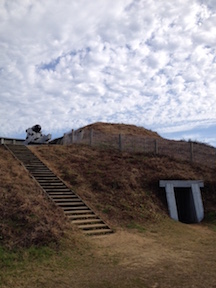 The mouth of the Cape Fear River ends in a messy maze of barrier islands, sandbars, and shoals, but the commuter ferry seems unconcerned. It goes about its morning work in the same matter-of-fact way its passengers do. The morning rush has passed, so there’s a more relaxed pace and people read their papers and absently swirl half-full cups of coffee. The beautiful scenery of the cape slides by as unnoticed background.
The mouth of the Cape Fear River ends in a messy maze of barrier islands, sandbars, and shoals, but the commuter ferry seems unconcerned. It goes about its morning work in the same matter-of-fact way its passengers do. The morning rush has passed, so there’s a more relaxed pace and people read their papers and absently swirl half-full cups of coffee. The beautiful scenery of the cape slides by as unnoticed background.
The ferry chugs from Southport in a slow, long diagonal to the far shore. I could not ask for a nicer day to be out on the water, particularly for the beginning of February. By the end of the day, temperatures will hit 70°.
With me, Mike Powell and Wally Rueckel of the Brunswick Civil War Roundtable plan our assault on Fort Fisher. This is my first trip here, but Mike and Wally know the terrain well. They bring their roundtable speakers out to the fort any time any of the speakers want to do some battlefielding while they’re in town. I spoke to the group last night, and Mike and Wally are returning the favor by showing me the sights.
“How do you guys keep it fresh, bringing people out here as often as you do?” I ask.
“It’s a treat just to be able to show off a place we love so much,” Mike tells me.
“It’s fun going out on the field with people who appreciate it,” Wally adds.
The ferry slides up to its docking point and a metal ramp clangs down. Crew members remove the heavy rope that blocks our exit from the ferry, and cars begin to disembark one by one. Mike takes us to the right to first head down to the southern end of the peninsula, away from Fort Fisher, toward the location of the battery that supported it.
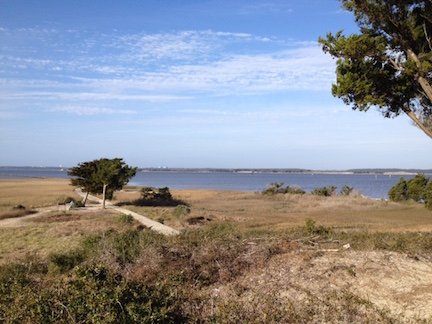 Little remains of Battery Buchannan today beyond a mound of sand still held in place by stubborn-rooted shrubs that squat against the wind. As I walk to the top of the rise, I’m oddly excited by the prospect of getting a little sand in my shoes—a comfortingly telltale sign that, yes indeed, I am at the beach.
Little remains of Battery Buchannan today beyond a mound of sand still held in place by stubborn-rooted shrubs that squat against the wind. As I walk to the top of the rise, I’m oddly excited by the prospect of getting a little sand in my shoes—a comfortingly telltale sign that, yes indeed, I am at the beach.
Southward looks so desolate and beautiful. For a moment, it’s easy to forget the rest of the world. We look out over “new inlet,” protected by an Army Corps of Engineer’s “defense dam,” built between 1871-1883. Otherwise, the forces of wind, tide, and time play out before us in ultra-slow motion.
Mike takes us back northward, past the North Carolina Aquarium the hunches on the ocean side of the peninsula. It hardly seems busy enough here to support an aquarium, I think. Only later, when we drive north out of the state park, that I’ll see just how developed and touristy this stretch of North Carolina’s coastline really is. For now, I’m still isolated in an illusion of remoteness.
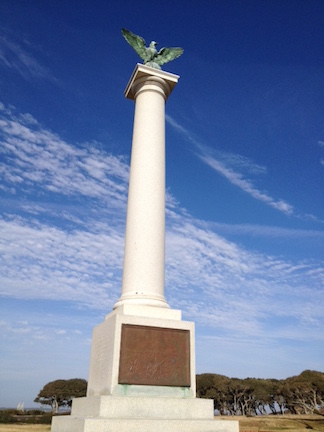 We park in front of a monument commemorating Fort Fisher’s defenders. Erected by the United Daughters of the Confederacy in April of 1832, the eagle-topped granite shaft tells the story of the fort through a Southern lens:
We park in front of a monument commemorating Fort Fisher’s defenders. Erected by the United Daughters of the Confederacy in April of 1832, the eagle-topped granite shaft tells the story of the fort through a Southern lens:
During the War Between the States, 1861-1865, Fort Fisher was the defense of the last open port of the Confederacy. here a combined naval and military assault by Federal forces was repulsed on December 24 and 25, 1864. The fort was captured on the night of January 15, 1865. After three days combined bombardment by more than 55 enemy warships and attacks by 10,000 land forces. The garrison of the fort, 1900 men, was composed entirely of North Carolinians with the exception of 350 South Carolinians.
The monument stands approximately where the fort’s headquarters was once situated. On the backside of the monument is a grave to an unknown soldier.
Looking at the monument, the outer wall of the fort would have been to our backs, but yeas ago, the ocean swallowed it. (See my previous post about the effects of erosion on the fort over the years.) Now, a small parking area overlooks the sea. I suspect it’s been a popular spot for such sea-gazing for a long while. Once upon a time, a pavilion even covered this area; four squat cement obelisks, nearly swallowed by beach scrub, still mark the corners of the field.
The sea-swallowed east face of the fort once comprised of batteries and batteries—8- and 10-inch Columbiads, 32-pounder rifled cannons, 7-inch Brookes, and 8-inch Armstrongs. Mike gives me a trove of maps that show the placement of the artillery, the locations of the cape’s network of forts and batteries, the directions of the troop movements, and historical and modern views. He’s a regular Jed Hotchkiss—had Hotchkiss ever served on the Carolina coast.
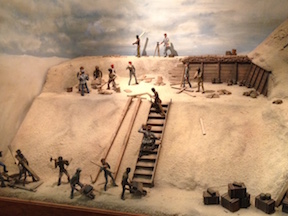 The three of us circle around to the North Carolina Historic Sites visitor center, which sits like an 1960s-era “Mission 66” building—dark, paneled, and suspicious-looking—just outside the fort’s massive northeast wall. The museum inside is fantastic, with a great collection of artifacts from the fort and the battles, old-school dioramas that depict various episodes in the fort’s history, and displays that outside stories of civilians and soldiers. Other displays tell of the fort’s post-Civil War history and its losing battle against nature. Overall, the museum tells an impressively well-rounded tale—well worth the stop we make.
The three of us circle around to the North Carolina Historic Sites visitor center, which sits like an 1960s-era “Mission 66” building—dark, paneled, and suspicious-looking—just outside the fort’s massive northeast wall. The museum inside is fantastic, with a great collection of artifacts from the fort and the battles, old-school dioramas that depict various episodes in the fort’s history, and displays that outside stories of civilians and soldiers. Other displays tell of the fort’s post-Civil War history and its losing battle against nature. Overall, the museum tells an impressively well-rounded tale—well worth the stop we make.
 Outside, a replica Armstrong cannon sits caged within a wrought-iron fence, as though Yankees might appear at any moment and try to haul it away. But as elephantine as the artillery piece looks, it’s nothing compared to the hulking remnants of Forth Fisher that stretch away to our right in the direction of the Cape Fear River. A post fence of sharpened stakes lines the front of the fort, and the muzzles of cannons peek over the top of the mounds.
Outside, a replica Armstrong cannon sits caged within a wrought-iron fence, as though Yankees might appear at any moment and try to haul it away. But as elephantine as the artillery piece looks, it’s nothing compared to the hulking remnants of Forth Fisher that stretch away to our right in the direction of the Cape Fear River. A post fence of sharpened stakes lines the front of the fort, and the muzzles of cannons peek over the top of the mounds.
When I hear “fort,” I think of Fort Sumter or perhaps even Penobscot Bay’s Fort Knox in Bucksport, Maine, but I’ve seen enough earthen forts along the Petersburg siege lines to know that forts come in many shapes and sizes. Fort Fisher is the sand-heap cousin of those earthen Petersburg forts, yet it’s the most incredible heap of sand I have ever seen. Sand is the impermanent stuff of beaches and deserts and hourglasses, all passing away through time. Fort Fisher, in contrast, is the earth itself, risen up like a massive ocean swell and frozen in place by the grass that covers its escarpments.
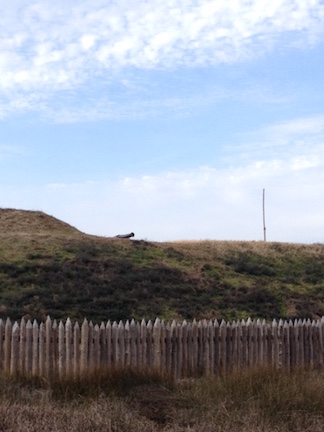 Federals had to cross an open torpedo field, chop their way past the wood palisades, and scale the steep sandy slopes of the fort in order to break through. Good lord.
Federals had to cross an open torpedo field, chop their way past the wood palisades, and scale the steep sandy slopes of the fort in order to break through. Good lord.
The task fell to Brig. Gen. Adelbert Ames’ 2nd division of the XXIV Corps, which assaulted on January 15, 1865, after a two-day naval bombardment. Their breakthrough came at the fort’s sally port—known thereafter as “the Bloody Gate”—and then swept across the fort’s interior from its western cape-side to its eastern sea-side.
Mike, Wally, and I follow the route of the Federal advance through the gate, more remarkable now for the marsh of cattails than carnage. Inside, we climb to one of the fort’s interior artillery platforms, which gives us a chilling view of the killing fields below.
Usually, “the beach” brings only thoughts of delight. But this was no day at the beach, not by a long shot. I think of the Carolina summer heat and the ever-present sand-scouring and the swarms of mosquitos that must have risen in clouds from the surrounding salt marshes. What a miserable place this must have been to serve.
Yet how beautiful it is, too—impressive, almost magisterial in its silence.
Our drive to Fort Fisher has been a success.
* * *
For more information about the site, visit Friends of Fort Fisher
My thanks to Mike Powell, Wally Rueckel, and the Brunswick Civil War Roundtable for their hospitality during my time in Southport!
My husband and I spent several hours at Fort Fisher a few years ago when I was thinking about doing a bio of Alfred Howe Terry., (I gave the idea up because the man never wrote his memoirs and his personal letters, to his sister, weren’t very personal. I did another horse book instead–they never write their memoirs). I loved the tour…it’s a very evocative place. There’s also a nice little museum. The site manager at the time, whose name I unfortunately don’t remember, was extremely helpful. I’d recommend Fort Fisher to anybody who has an interest in the Civil War.
now retired ill have to put it on our bucket list of sites to viist thanks Chris look forward to your vivisi back to buffalo